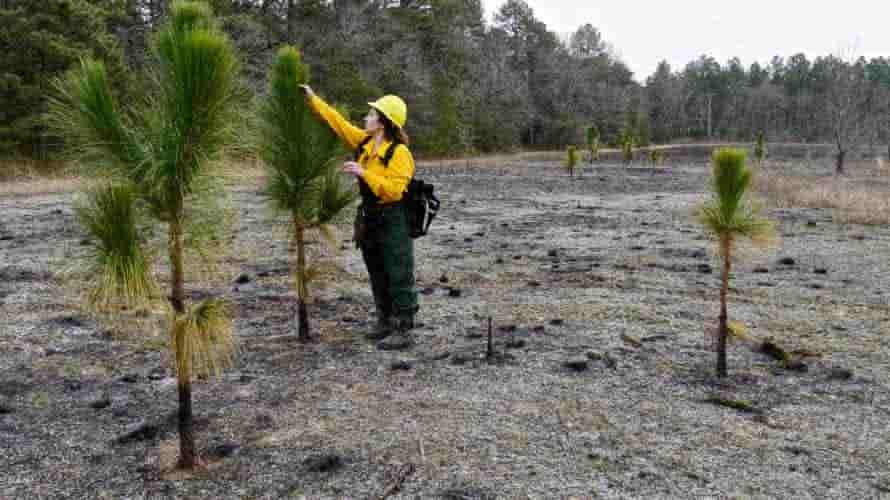Scientists look to soils to learn how forests affect air quality, climate change
Trees are often heralded as the heroes of environmental mitigation. They remove carbon dioxide from the atmosphere, which slows the pace…

[Jan. 29, 2021: Indiana University]
Trees are often heralded as the heroes of environmental mitigation. They remove carbon dioxide from the atmosphere, which slows the pace of climate change, and sequester nutrients such as nitrogen, which improves water and air quality.
Not all tree species, however, perform these services similarly, and some of the strongest impacts that trees have on ecosystems occur below the surface, away from the eyes of observers. This complicates efforts to predict what will happen as tree species shift owing to pests, pathogens, and climate change as well as to predict which species are most beneficial in reforestation efforts.
Additionally, researchers have sought for years to understand how and why forests comprised of different mixtures of tree species differ in their functioning. Because of the large number of species on Earth, it is impractical to study each tree species' unique effects on carbon and nutrient cycling. Recently, there has been a push to classify trees into groups to help predict the consequences of tree species shifts.
Now, researchers at Indiana University -- in collaboration with scientists from West Virginia University, Jet Propulsion Laboratory, the University of Virginia, and the University of Warwick -- have found that classifying temperate forest trees based on the type of symbiotic fungi with which the trees associate can serve as a broad indicator of how the trees and forests function.
Nearly all trees associate exclusively with one of two types of mycorrhizal fungi. These specialized fungi form mutualistic relationships with tree roots--enhancing the tree's ability to obtain nutrients from soil in exchange for carbon from the tree. Because the type of fungi with which a tree often associates reflects and determines how trees function, grouping trees based on their mycorrhizal fungi has been proposed to be a good way to classify trees.
In two studies, published in Global Change Biology and Ecology Letters, the researchers reported that forest stands dominated by trees that associate with arbuscular mycorrhizal (AM) fungi differ from stands dominated by trees that associate with ectomycorrhizal (ECM) fungi in terms of how they store and retain carbon and nitrogen.
In the first study, the authors found that AM-associating trees such as maples, tulip trees, cherry, and ash, which produce fast-cycling detritus, promote soil microbial communities that have more genes capable of processing nitrogen. This leads to the release of nitrogen gases that reduce air quality. In contrast, ECM-associating trees such as oaks, hickories, beech, and hemlock produce slow-cycling detritus that promotes microbial communities with few nitrogen-cycling genes, leading to lower gaseous nitrogen losses.
Like these kind of stories? Get The Brighter Side of News' newsletter.
To understand the link between tree species and the functioning of soil microbes near these trees, the researchers collected soils from 54 plots spread evenly across six forests in the eastern United States. Each site had both AM- and ECM-associating trees. They extracted DNA from the soils in each plot and looked for the abundance of genes critical to nitrogen cycling. They then placed soils in closed chambers in the laboratory to measure how much nitrogen gas is released from the soil and to determine whether this relates to the abundance of nitrogen-cycling genes.
"Regardless of which tree species were present, we found nearly 5-fold more nitrogen cycling potential in the plots dominated by AM trees," said Ryan Mushinski, the lead author of the study. "It's very exciting that the trend is consistent across the eastern United States, indicating we may be able to predict nitrogen-cycle activity, and more importantly the gaseous loss of nitrogen, in other temperate forests around the world."
Mushinski, who conducted the study as a postdoctoral researcher in the Department of Biology and O'Neill School of Public and Environmental Affairs at Indiana University, is continuing this work in his role as an assistant professor at the University of Warwick, U.K.
"Simplifying the complexity of forest soil, and being able to predict the spatial variability of soil emissions of nitrogen gases, was once thought to be an impossible task," said Jonathan Raff, an associate professor and atmospheric chemist in the O'Neill School and co-author of the study. "Some of these gases are very hard to measure," added Raff, whose lab made the measurements, "but these gases are incredibly important for air quality and climate change mitigation."
In the second study, led by Adrienne Keller, who was a Ph.D. student in the IU Department of Biology at the time of the study and now a postdoc at University of Minnesota, researchers found that forests dominated by AM trees enhance soil carbon storage by releasing carbon from their roots. Keller packed mesh cores with root-free soil and inserted the cores in the same 54 forest plots as Mushinski.
Because the soil inside the cores had a unique chemical signature, she was able to separate the carbon released from roots from the carbon already present in the soil. Keller found that roots of AM trees release more carbon to soil than the roots of ECM trees and that much of the root carbon sticks to the surface of soil minerals where it is protected from microbial decay. This means that root carbon may persist for decades or longer, especially in AM-dominated stands.
"It's challenging to measure how much carbon plants shuttle from their roots to the soil," Keller offered. "Here we were able to not only quantify the amount of root carbon sequestered in the soil, but also show that its magnitude rivals that of aboveground plant inputs."
"There's been a shift in our thinking over the past decade about what controls soil carbon storage," said Richard Phillips, professor of biology in the IU Department of Biology and co-author on both studies. "We used to think that slow decaying leaf detritus was the main driver of soil carbon storage, but we now know that fast-decaying compounds released by roots may be what causes soil carbon to persist." Phillips added.
While more work is needed to explore the generality of these patterns beyond eastern forests of the United States, the two studies indicate that as species come and go in our forests, the ecosystem consequences are likely to be difficult to predict. While AM trees may increase nitrogen-cycling rates--with negative consequences for things like air quality--they may also increase soil carbon storage which can, in turn, slow climate change. Given the number of initiatives to plant trees globally as part of global reforestation efforts (mostly to slow climate change), land managers would be wise to consider what's happening in the soils, where roots and soil microbes are carrying out critical but underappreciated ecosystem functions.
Funding for the studies was provided by the U.S. Department of Agriculture (Agriculture and Food Research Initiative, National Institute of Food and Agriculture), the U.S. Department of Energy (Office of Biological and Environmental Research, Environmental System Science Program and Terrestrial Ecosystem Science Program), and the Smithsonian Center for Tropical Forest Science, ForestGEO Program.
Tags: #Green_Good_News, #Carbon_Emissions, #Trees, #Soil, #Climate_Change #The_Brighter_Side_of_News



